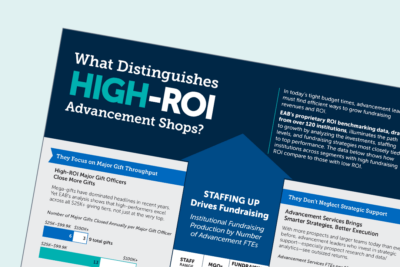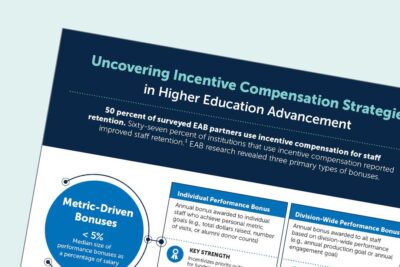Maximizing Fundraiser Efficiency in Higher Ed
Use this study to scale cultivation strategy development to meet donor expectations within current staff capabilities and time allocation and maximize fundraiser efficiency in higher ed.
Major gift officers (MGOs) often comprise the single largest staff investment within any development team, but chief advancement officers are increasingly questioning whether MGO productivity justifies the cost. Instead of investing in additional frontline fundraisers, advancement teams are increasingly considering how to grow fundraising productivity by helping current staff work more efficiently at every point in the cultivation cycle.
To move beyond fundraisers’ current challenges, advancement teams should focus on three critical areas for improved efficiency. First, advancement leaders should provide MGOs with the tools to implement creative cultivation strategy without rewriting the playbook for every major gift prospect. Second, managers of frontline fundraisers should deploy goal-setting and data tracking to provide targeted, proactive coaching for MGO challenges and skill gaps. Third, advancement should take the lead in rethinking how MGOs spend their time in order to refocus on fundraising.
Section 1: Develop donor strategy at scale
The expectations of major gift donors have become increasingly challenging for gift officers to meet. Today’s top donors, identified as “donor-investors,” share a philanthropic mindset characterized by a desire for transformative impact, hands-on engagement, and bold ideas. Development teams are accustomed to meeting these demands for a handful of individuals at the top of the giving pyramid, but this mindset has expanded down the giving pyramid and beyond advancement teams’ capabilities. Major gifts have become increasingly customized, and annual fund supporters seek an “Amazon experience” with a wide selection of cause-based giving opportunities instead of one-size-fits-all unrestricted gifts.
Section 2: Enhance intermediate goal accountability
Gift officers often struggle to cover their entire portfolios because they are not accustomed to high-volume project management. Today’s major gift landscape is more complex than ever, as escalating donor demand for customized interactions requires MGOs to think about every prospect as a unique campaign into itself. Planning and carrying out these pursuits requires strong project management skills, but gift officer recruitment often prioritizes donor-facing skills, like experience making the ask, communicating with stakeholders, and staying cool under pressure. As a result, MGOs face a skill mismatch between the skills they bring to the role and the expectations thrust upon them.
Section 3: Realign time investments
Gift officer productivity is a critical driver of advancement’s return on investment at every institution. Major and principal gift officers represent the largest segment of development staff, and a significant portion of annual budgets is invested in their salaries. While salary figures depend substantially on market competitiveness and tenure, large investments in frontline fundraising mean that advancement teams need to maximize the ROI from staffing investments, including allowing fundraisers to bring in as many new gifts per month as possible.
More Resources

What distinguishes high-ROI advancement shops?

3 Data Insights from Higher Ed Advancement Shops
